 Who: Art Spiegelman is a New York City-based graphic artist, writer and editor. Since launching his career in New York’s underground comix scene of the 1960s, Spiegelman’s work has helped redefine comic book storytelling. His autobiographical approach produced 1986’s landmark Maus: A Survivor’s Tale (and its 1991 followup, Maus II) about the wartime experiences of his parents Vladek and Anja, who survived incarceration in Auschwitz. Years later, after witnessing the September 11th, 2001 destruction of the World Trade Center from his downtown NYC home, Spiegelman expressed his feelings on the aftermath through illustrations in the German newspaper Die Zeit. These were later anthologized in 2004’s In The Shadow of No Towers. Spiegelman then worked with composer Marco Cappelli to adapt In The Shadow for a multi-media production that employed limited animation with live-performed music and narration, which debuted in Italy in 2008. Its 2011 DVD release marked the first high-profile film adaptation of Spiegelman’s comics work. It was preceded by “Hapless Hooligan in ‘Still Moving'”, a 2010 collaboration with Pilobolus dance company, combining live performance with animation — and was followed by the recently-premiered Wordless!, a multi-media lecture by Spiegelman on storytelling through graphic art, accompanied by on-stage jazz musicians. In advance of the January 18th, 2014 American premiere of Wordless! at the Brooklyn Academy of Music, The Jewish Museum in Manhattan is presenting a look back at Spiegelman’s career so far with Co-Mix: A Retrospective. The show (on through March 23rd) was originally organized by Rina Zavagli-Mattotti for the 2012 Festival International de la Bande Dessinée in Angoulême, France, and adapted for The Jewish Museum by curator Emily Casden. On the eve of his retrospective’s opening, Spiegelman appeared on stage at The Jewish Museum with its Deputy Director, Ruth Beesch for an interview about his career. I filed a story about their conversation for The Jewish Channel, and have transcribed it here.
Who: Art Spiegelman is a New York City-based graphic artist, writer and editor. Since launching his career in New York’s underground comix scene of the 1960s, Spiegelman’s work has helped redefine comic book storytelling. His autobiographical approach produced 1986’s landmark Maus: A Survivor’s Tale (and its 1991 followup, Maus II) about the wartime experiences of his parents Vladek and Anja, who survived incarceration in Auschwitz. Years later, after witnessing the September 11th, 2001 destruction of the World Trade Center from his downtown NYC home, Spiegelman expressed his feelings on the aftermath through illustrations in the German newspaper Die Zeit. These were later anthologized in 2004’s In The Shadow of No Towers. Spiegelman then worked with composer Marco Cappelli to adapt In The Shadow for a multi-media production that employed limited animation with live-performed music and narration, which debuted in Italy in 2008. Its 2011 DVD release marked the first high-profile film adaptation of Spiegelman’s comics work. It was preceded by “Hapless Hooligan in ‘Still Moving'”, a 2010 collaboration with Pilobolus dance company, combining live performance with animation — and was followed by the recently-premiered Wordless!, a multi-media lecture by Spiegelman on storytelling through graphic art, accompanied by on-stage jazz musicians. In advance of the January 18th, 2014 American premiere of Wordless! at the Brooklyn Academy of Music, The Jewish Museum in Manhattan is presenting a look back at Spiegelman’s career so far with Co-Mix: A Retrospective. The show (on through March 23rd) was originally organized by Rina Zavagli-Mattotti for the 2012 Festival International de la Bande Dessinée in Angoulême, France, and adapted for The Jewish Museum by curator Emily Casden. On the eve of his retrospective’s opening, Spiegelman appeared on stage at The Jewish Museum with its Deputy Director, Ruth Beesch for an interview about his career. I filed a story about their conversation for The Jewish Channel, and have transcribed it here.
On how he became interested in comics…
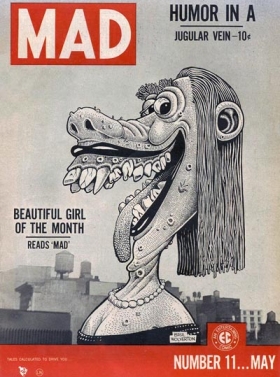 It really had to do with a paperback reprint of Mad in [1955]. So, I was [7] years old already. And my mother was in the drug store, and on the spinner rack there was a copy of Inside Mad. And I picked it up, and there was just reprints of other Mad covers on it — including one incredibly grotesque caricature, looking like the things that would later be turned into Garbage Pail Kids. It looked like a parody of Life magazine. It said, [“Beautiful Girl of the Month”] It was like one inch high. And I needed to have this. It wasn’t like optional. It was as soon as I saw it, I needed it. I’d already seen Donald Duck, and was already going, “This is important.” And I’d already understood that comics were made by people, and were not natural phenomena like trees. And therefore, I could be a person who did that sort of thing. But Mad is what did me in. And my mother really refused to get it for me. Because it was just one more whim, as far as she was concerned. And she was on a tight allowance from my dad. But eventually, the nagging was severe enough so that I got to bring it home. And the punchline to that particular comic strip is that I studied Mad the way other kids studied the Talmud.
It really had to do with a paperback reprint of Mad in [1955]. So, I was [7] years old already. And my mother was in the drug store, and on the spinner rack there was a copy of Inside Mad. And I picked it up, and there was just reprints of other Mad covers on it — including one incredibly grotesque caricature, looking like the things that would later be turned into Garbage Pail Kids. It looked like a parody of Life magazine. It said, [“Beautiful Girl of the Month”] It was like one inch high. And I needed to have this. It wasn’t like optional. It was as soon as I saw it, I needed it. I’d already seen Donald Duck, and was already going, “This is important.” And I’d already understood that comics were made by people, and were not natural phenomena like trees. And therefore, I could be a person who did that sort of thing. But Mad is what did me in. And my mother really refused to get it for me. Because it was just one more whim, as far as she was concerned. And she was on a tight allowance from my dad. But eventually, the nagging was severe enough so that I got to bring it home. And the punchline to that particular comic strip is that I studied Mad the way other kids studied the Talmud.
Mad changed my life. It was very specific. In fact, I think of Mad as an acronym that means “Mom And 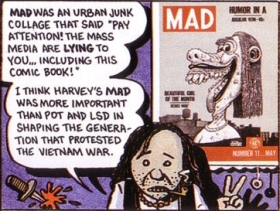 Dad.” It was my entry portal into America — my parents both being kind of fraught from some other culture, as you know. And here, this was the operating manual. So I would learn the parody version well before I ever was exposed to an original. From everything like The Raven, onto The Wild One.
Dad.” It was my entry portal into America — my parents both being kind of fraught from some other culture, as you know. And here, this was the operating manual. So I would learn the parody version well before I ever was exposed to an original. From everything like The Raven, onto The Wild One.
I was copying everything from Little Lulu and Donald Duck, to each one of the Mad artists as best I could. And then by the time I was about 14, I was doing a very bad pastiche of Mad printed in purple ink called Blasé.
On artists who inspired him…
The first thing that comes to mind, of course, is cartoonists. So there we have Harvey Kurtzman, and the rest of the Mad gang. But mostly, Harvey Kurtzman. Early on, it was John Stanley who did Little Lulu. And from there, it becomes really hard to say. Because things influenced me that I don’t like. But they influenced me. So even the really boring version of Superman and Superboy, which was done by a guy named Wayne Boring actually, influenced me. I didn’t want the influence, but it came. And then, it took a little bit further for me to discover the stacks of old newspapers in the main Queens library, and discover everything from Billy Debeck and Rube Goldberg, to Little Orphan Annie and Dick Tracy‘s prime. And all of those things became urgent for me. One after the other, and one on top of the other.
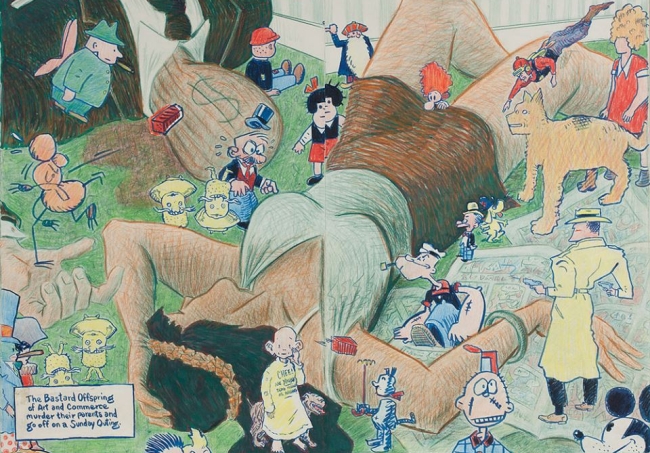
The rest of the art universe came much later. Because I was kind of a slob snob. And if it wasn’t on newsprint, who needed it? So, it was really much later. Although, I would play hooky from my high school, which was right near the Museum of Modern Art, to go there and hang out with my girlfriend, who I had made the co-editor of the school newspaper. Since I was the editor, and we had a pass to go wherever we wanted. But I didn’t really like much of the art, and I didn’t know what I was looking at. Unless it looked like a cartoon, I didn’t have much use for it.
So it was easiest for me to get onto the German Expressionists, and the New Objectivists, like Otto Dix and George Grosz came early. [Pablo] Picasso wasn’t the worst leap I had to make. You know, it was a lot harder to get into the AbEx artists and stuff. But the thing with Picasso was, I 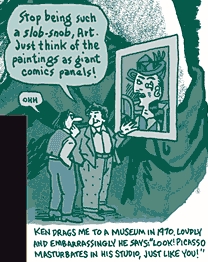 was really shown how to look at it by somebody who was important to me who is a great artist, who taught film at SUNY Binghamton, who became a good friend of mine after I’d gotten kicked out of the school. And I’d sit in on his classes, and he’s the one who just thought it was pathetic that I had no interest in this stuff that I was obviously destined to be interested in. So he would drag me to a couple of shows, and make look at Picasso, and said, “Just think of it as really large comic book panels, and don’t worry about it so much.” Ken Jacobs, a filmmaker working with 3D equipment, non-narrative film. That universe that exists at the Anthology Film Archives, and was shown on Turner Classic Movies at 4 AM just two nights ago.
was really shown how to look at it by somebody who was important to me who is a great artist, who taught film at SUNY Binghamton, who became a good friend of mine after I’d gotten kicked out of the school. And I’d sit in on his classes, and he’s the one who just thought it was pathetic that I had no interest in this stuff that I was obviously destined to be interested in. So he would drag me to a couple of shows, and make look at Picasso, and said, “Just think of it as really large comic book panels, and don’t worry about it so much.” Ken Jacobs, a filmmaker working with 3D equipment, non-narrative film. That universe that exists at the Anthology Film Archives, and was shown on Turner Classic Movies at 4 AM just two nights ago.
On how comic art has changed over the course of his career…
I think one of the things that made me interested in comics is that it was such a low-status version of making something, that there’s a lot of room to make stuff. And there’s nobody to be interested, but there’s nobody to say, “No.” And that was very interesting to me. And yet, sometime in the ’70s, when I was involved in the underground comics thing, I very consciously had this thought that we have to make a Faustian deal with the culture. Comics were already no longer a mass, mass, mass medium. And it seemed to me that, based on having read [Marshall] McLuhan, when something’s no longer a mass, mass, mass medium or technology, it either disappears or becomes art.
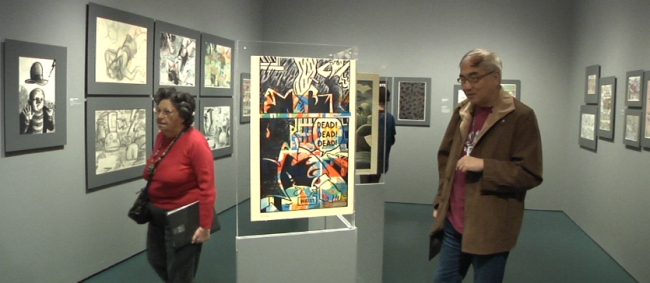
I’d already been trying to get grants like from New York Council of the Arts and stuff. And I didn’t know what category to apply, and they didn’t know what category to put me in. And they said, “Oh, words and pictures. We don’t know whether to put you in writing, or drawing. So we’ll put you in mixed media.” At which point, Nam June Paik would always walk away with another grant, and I was left high and dry. So, the idea was to make this deal where comics could be accepted into libraries, book stores, university studies, and museums and galleries. In exchange for that, artists would then be able to sneer and say, “Eh, the best comics are pornographic and non-newsprint.” But there’d be a medium from which to say that, as opposed to a steady erosion of comic books and comic strips becoming far less important than they had been 100 years earlier.
On how comics have been a medium for self-expression…
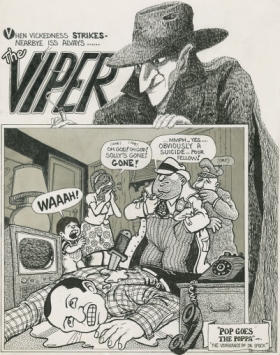 The underground comics that I mentioned in passing were really significant. Because it was the first time that comics had a self-aware avant-garde. There were avant-garde comics. I mean, Winsor McCay, who I should have mentioned in influences, of Little Nemo, George Herriman‘s Krazy Kat. And both of those in part influences, because I love them. And in part because they were actually given an exemption from the “It’s all garbage” clause in the cultural contract. And I guess I had lower middle class aspirations, even while sneering at the museums that I was being put into every once in a while.
The underground comics that I mentioned in passing were really significant. Because it was the first time that comics had a self-aware avant-garde. There were avant-garde comics. I mean, Winsor McCay, who I should have mentioned in influences, of Little Nemo, George Herriman‘s Krazy Kat. And both of those in part influences, because I love them. And in part because they were actually given an exemption from the “It’s all garbage” clause in the cultural contract. And I guess I had lower middle class aspirations, even while sneering at the museums that I was being put into every once in a while.
Underground cartoonists were aware that they didn’t have to follow the rules. If anything, it was almost a given that you had to break the rules. So that that comic code of America in the ’50s, that said, “Good must always win. Cops can’t be shown in a bad light. No indication of sex being pleasurable.” Or whatever. All of that was like itemized in the comic code of America little seal in the upper right hand corners. And it seemed like the underground comics mandate was to have a checklist, and see if you had gotten through each of those. “Ok, cop killed. Good.” And so on. And that allowed certain things to happen. And at first, for me that self-expression consisted of me being unconscious of what I was 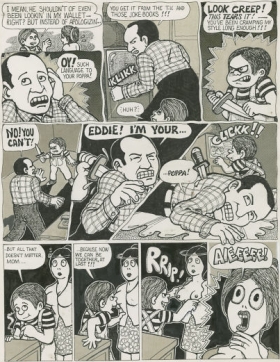 doing. So there’s a couple of splash pages in the show from my underground comics period that include the nastiest things I could think of drawing. Because I was a few years younger than the other underground cartoonists who really had defined the medium. And in a way, it set me back. Because I was already off in a very strange direction, but now had to become an apprentice. And as an apprentice, what I had to do is do something that was weirder than anything Crumb could do, or S. Clay Wilson, who did the Pervert Pirates and [Ruby the Dyke], and things like that. And in that, I ended up doing the most vile and horrible things I could visualize and come up with. And I was so successful at it, that Crumb’s wife wouldn’t let me into the house. But then, I realized that I’m really working without understanding. Like it was very violent, really creepy. I won’t even tell you what it was. But the result of all of that was I realized I was dealing with atrocity through like media studies. Not through my own life. And that was made possible by a very significant for me influence, and cartoonist, and friend, Justin Green, who really brought the idea of autobiographical content to comics. And it’s what gave me permission to pursue what became the first 3-page Maus, and Prisoner on the Hell Planet. And gave Crumb permission to become more autobiographical as well, for example. And ultimately, that
doing. So there’s a couple of splash pages in the show from my underground comics period that include the nastiest things I could think of drawing. Because I was a few years younger than the other underground cartoonists who really had defined the medium. And in a way, it set me back. Because I was already off in a very strange direction, but now had to become an apprentice. And as an apprentice, what I had to do is do something that was weirder than anything Crumb could do, or S. Clay Wilson, who did the Pervert Pirates and [Ruby the Dyke], and things like that. And in that, I ended up doing the most vile and horrible things I could visualize and come up with. And I was so successful at it, that Crumb’s wife wouldn’t let me into the house. But then, I realized that I’m really working without understanding. Like it was very violent, really creepy. I won’t even tell you what it was. But the result of all of that was I realized I was dealing with atrocity through like media studies. Not through my own life. And that was made possible by a very significant for me influence, and cartoonist, and friend, Justin Green, who really brought the idea of autobiographical content to comics. And it’s what gave me permission to pursue what became the first 3-page Maus, and Prisoner on the Hell Planet. And gave Crumb permission to become more autobiographical as well, for example. And ultimately, that 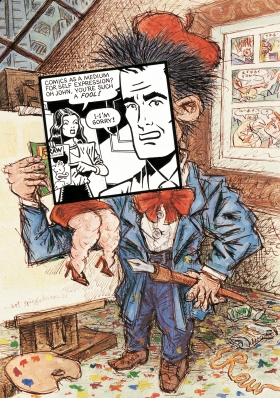 was really important. And my friend Ken Jacobs, aforementioned, got me really interested in the formal aspects of comics. Once I started understanding what the system was for painting, what people were up to, that allowed me to sort of like poke myself into saying, “Well, let’s say comics hadn’t been a priori modernist just by being invented in the 1890s, and merrily going off that way. But if those people were approaching what they were doing with the same rigor that, I don’t know, Picasso was doing at the same time that comic books were getting invented — what would it have led to?” And that made for a significant portion of my own place in comics, let’s say.
was really important. And my friend Ken Jacobs, aforementioned, got me really interested in the formal aspects of comics. Once I started understanding what the system was for painting, what people were up to, that allowed me to sort of like poke myself into saying, “Well, let’s say comics hadn’t been a priori modernist just by being invented in the 1890s, and merrily going off that way. But if those people were approaching what they were doing with the same rigor that, I don’t know, Picasso was doing at the same time that comic books were getting invented — what would it have led to?” And that made for a significant portion of my own place in comics, let’s say.
The autobiographical impulse is there. And I never really mastered fiction. It’s like, when all this retrospection is over, I think I’d like to give it one more shot. Except, last time I tried, I started doing a biography of the man who invented a pre-Robert McKee system of how to tell stories. Which isn’t exactly the same as writing fiction. So, I don’t know.
On his project with Pilobolus, the 50-foot mural for his high school, and Wordless…
Pilobolus, they wore me down. They were wonderful sweet people, but it was really like, “What do I wanna do this for?” I think The Red Shoes was the kind of worst movie I ever had to sit through in my life. And I just didn’t have a category open for this. And they were just really fine folks. They were amusing and they were just, “Well, we’ll work something out. Just collaborate.”
And I did have a failed collaboration with the person I just did this Wordless project with. A composer named Phillip Johnston.
I was working on a music theater thing about the rise and fall of the American comic, called Drawn to 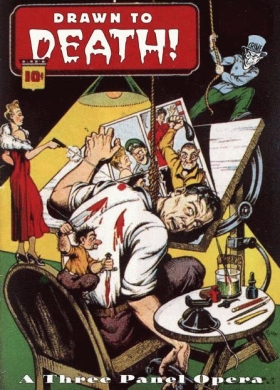 Death. And I didn’t know enough about avant-garde theater to realize that I fell somewhere between Rent and Robert Wilson — which is not a good place to fall. And I just could never figure out how to get it mounted. I figured out how to do it workshop after workshop. But I always wanted to work with Phillip again, which is what led to it. But the stage ideas for Drawn to Death were very applicable to working with the dance company, which was seeing people dance between panels, but having balloons come out of their mouths, have drawn and 3D objects mixing together, became the core of what led to the Pilobolus collaboration. The other one was just ever since I saw a stained glass window, I just figured, “comics before newsprint.” And I just wanted to make one.
Death. And I didn’t know enough about avant-garde theater to realize that I fell somewhere between Rent and Robert Wilson — which is not a good place to fall. And I just could never figure out how to get it mounted. I figured out how to do it workshop after workshop. But I always wanted to work with Phillip again, which is what led to it. But the stage ideas for Drawn to Death were very applicable to working with the dance company, which was seeing people dance between panels, but having balloons come out of their mouths, have drawn and 3D objects mixing together, became the core of what led to the Pilobolus collaboration. The other one was just ever since I saw a stained glass window, I just figured, “comics before newsprint.” And I just wanted to make one.
If it hadn’t been that it was my alma mater, I would have bailed at a certain point. Because working with the bureaucracy of the percent for the arts, and the board of education probably would have done me in.
I tried to make it really user-friendly. So on the one hand, it looks like it could fit into a kindergarten. And then, the more time you spend with it, the more depressing it gets. But basically, it allowed for something that has a long half-life. I wanted it to be seen in the cafeteria.
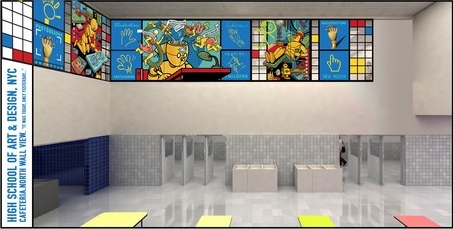
That was important to me, because that’s where real life takes place in high school. And the fact that you were seeing it every day, meant that like things could open up, because you were somehow sitting there brooding there about who you can copy math homework from, or whether some young woman at the other class would give you the time of day. And you’re staring off into space, and go, “Oh, I 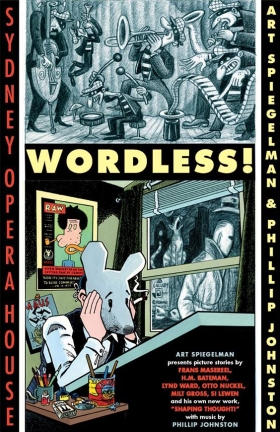 never noticed that before.” And that was like a “Eureka” important thing to teach. That these things should be built with layers.
never noticed that before.” And that was like a “Eureka” important thing to teach. That these things should be built with layers.
While I was working on it, a lot of it had to do with me hearing Vladek’s voice in my head saying, “Goyishe kopf! For 8 months you’re working on something that’s gonna last for an hour and a half, and you’re getting like $8,000 for it. What are you, crazy?” And it’s one of these things where I have no choice but to follow my own conscience. And it led me toward doing this thing when it became even remotely possible to do something at the Sydney Opera House. And it did allow me to work with Phillip, that I really enjoyed doing. But what it was was an insane project. It’s a hybrid between an academic lecture, a slide show, making movies out of books, and then making these silent movies out of these silent picture stories that were popular in the ’20s and the ’30s, and turning them into full-composed 6-piece band compositions. That people would be flipped between their left brain, where they get to hear this lecture about Gotthold Lessing, and this right brain where they would be seeing all this amazing material. It’ll be at BAM. Now it’s like, “See Dad, I’m getting another 8,000 bucks.”
On what it feels like to have a mid-career retrospective…
Well, that’s what we’re about to find out. Whether it’s the middle, or whether the rest of the time is just giving interviews. Even when I was first dragged into it in its first venue, I did not want this. I mean, I had now read enough about art to know that [Willem] de Kooning said, “Never have a retrospective while you’re 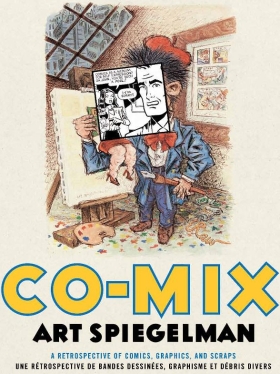 still alive.” But then, through the internet, found out he had two. And [I] allowed it to happen with certain caveats. Like Rina Mattotti, who came up earlier, is the only reason I was able to move forward. Because I just couldn’t bear to look back. I’d just finished retrospecting, thank you, with MetaMaus and the Breakdowns book that came out. And this made it possible, and it scared me. And because I had somebody I could fully trust — “Just go through the drawers. Do what you think is right.” — and she did, and she was. And the result is, once it was coming up, it was important to me that it travel. Because I’m enough of a snob to not be thrilled that it would be 8 months of work, that would then lead to 3 days in a small village in France, that would have 300,000 people in that village for the 3 days, and then 30 people in the village for the rest of the 6-month gig. So, then it was able to travel. And I’m really so happy it’s allowed to end in New York. And end. Even though I’m hearing whisperings that somebody else would like to do it in Canada, or whatever. It’s great that it can kind of land back here, and land here. Because basically, one of the most important ways my work — certainly Maus — was ever shown, was before it was kosher to show it. Back in the very early-’80s, like before Maus came out, at least. ’85, I would guess. There was some show of “Jewish Voices, New Directions”, or something, Susan Goodman did. And she found out about Maus, wanted to show some of it. And it was on display with other new work at a time where that just wasn’t plausible. And my publisher was terrified that I
still alive.” But then, through the internet, found out he had two. And [I] allowed it to happen with certain caveats. Like Rina Mattotti, who came up earlier, is the only reason I was able to move forward. Because I just couldn’t bear to look back. I’d just finished retrospecting, thank you, with MetaMaus and the Breakdowns book that came out. And this made it possible, and it scared me. And because I had somebody I could fully trust — “Just go through the drawers. Do what you think is right.” — and she did, and she was. And the result is, once it was coming up, it was important to me that it travel. Because I’m enough of a snob to not be thrilled that it would be 8 months of work, that would then lead to 3 days in a small village in France, that would have 300,000 people in that village for the 3 days, and then 30 people in the village for the rest of the 6-month gig. So, then it was able to travel. And I’m really so happy it’s allowed to end in New York. And end. Even though I’m hearing whisperings that somebody else would like to do it in Canada, or whatever. It’s great that it can kind of land back here, and land here. Because basically, one of the most important ways my work — certainly Maus — was ever shown, was before it was kosher to show it. Back in the very early-’80s, like before Maus came out, at least. ’85, I would guess. There was some show of “Jewish Voices, New Directions”, or something, Susan Goodman did. And she found out about Maus, wanted to show some of it. And it was on display with other new work at a time where that just wasn’t plausible. And my publisher was terrified that I 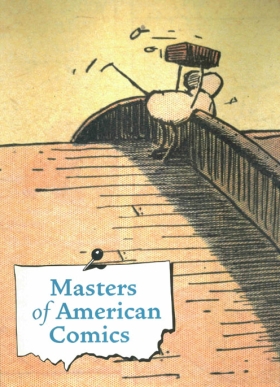 would be like Frankenstein’s monster, run out of town by like villagers with torches, because I did a comic book about this stuff. So, that was a great way for it all to begin. And then I thought, it made up for the fact that I had to do this kind of weird dance a few years ago, where a show that had started in California that I was involved with, called [Masters of American Comics]. Well, the thing is that that show started out as something I had petitioned for, after seeing the High [and] Low show at the MOMA. Going, “This doesn’t do the trick,” to show [Roy] Lichtenstein‘s paintings as actual art — and as a footnote, the things that Lichtenstein stole from. Whether they were good comics, or not so good, didn’t matter. It created an unequal footing on which to look at it. And therefore, that show was kind of like just a ratification of the MOMA’s choices over several generations. So, I invited some curators to my studio. And I’m amazed at how many showed up. And it was a discussion of reparations for the High Low show — wanting specifically a “Low Low” show. And the result was a number of people were interested. It just all crashed and burned. But one of the people who was there, Ann Philbin, who’s a friend who operated out of the Drawing Center in my neighborhood, eventually got made director of the Hammer Museum, and said, “We’re gonna do your show.” I said, “Great. As long as I’m not doing it.” And so, John Carlin took it on. I became an adviser, but didn’t always get my way. It was a great show out in L.A., and then went to the Midwest and was a great show.
would be like Frankenstein’s monster, run out of town by like villagers with torches, because I did a comic book about this stuff. So, that was a great way for it all to begin. And then I thought, it made up for the fact that I had to do this kind of weird dance a few years ago, where a show that had started in California that I was involved with, called [Masters of American Comics]. Well, the thing is that that show started out as something I had petitioned for, after seeing the High [and] Low show at the MOMA. Going, “This doesn’t do the trick,” to show [Roy] Lichtenstein‘s paintings as actual art — and as a footnote, the things that Lichtenstein stole from. Whether they were good comics, or not so good, didn’t matter. It created an unequal footing on which to look at it. And therefore, that show was kind of like just a ratification of the MOMA’s choices over several generations. So, I invited some curators to my studio. And I’m amazed at how many showed up. And it was a discussion of reparations for the High Low show — wanting specifically a “Low Low” show. And the result was a number of people were interested. It just all crashed and burned. But one of the people who was there, Ann Philbin, who’s a friend who operated out of the Drawing Center in my neighborhood, eventually got made director of the Hammer Museum, and said, “We’re gonna do your show.” I said, “Great. As long as I’m not doing it.” And so, John Carlin took it on. I became an adviser, but didn’t always get my way. It was a great show out in L.A., and then went to the Midwest and was a great show.
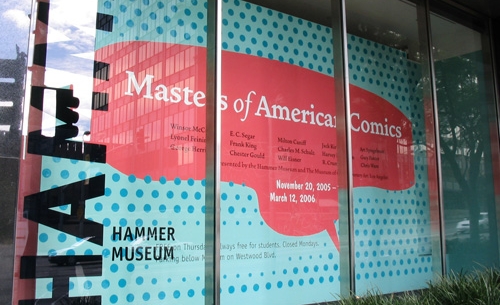
And when it came here, something went haywire. Half the show ended up in Newark. Half the show ended up here. And I felt it was a bad idea to have the comic book material, that had been at the Museum of Contemporary Art in L.A., here, because it meant that 3 out of the 5 artists were Jewish. Or maybe 4. 3 1/2. And one of them was me. And there’s something I’d learned long ago, which is that Holocaust trumps art every time. Especially when the word “Jewish Museum” might be mentioned in the same context. It would just obliterate the whole wiring of the show. And reluctantly, pulled out.

Because I’d offered an alternate solution, which is that each museum have all 15 artists that were displayed in the two museums in L.A. That didn’t fly. It was a lot of work, and whatever. So I reluctantly pulled out, and had some of my worst fears realized when a Jewish comic artists show was shown to fill in the gap. Because that’s a different narrative, and an interesting one — really interesting — that I’d actually proposed to the museum right after that New Voices show. But it’s not the same show that would happen here. And now I felt I could come back. Because if Holocaust trumps art every time, it might as well happen to me, without dragging all of the artists I admire into that.
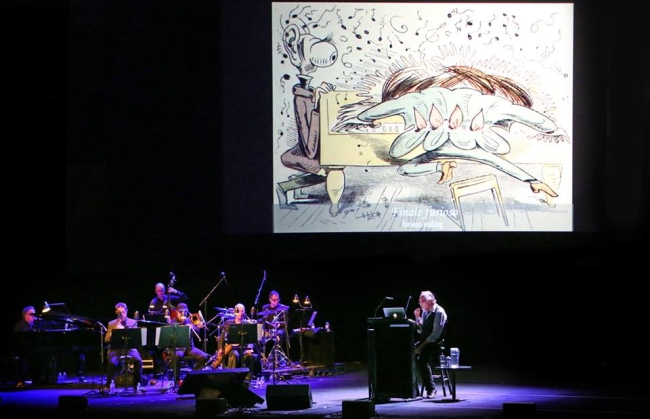
On the “Still Moving” portion of his retrospective…
Up to that moment that that was made a separate corner of the exhibit, as you walk out, I really thought, “I’ve done nothing for 8 years, but retrospect. Nothing.” And I’d done a few little stray things, but I didn’t quite realize that while that was going on, it was literally the same period that I was doing these three projects. And to have it all make sense, because I just wasn’t paying attention to stepping back and saying, “Oh yes, he’s involved in cross-pollinating his medium with other media.” Oh, I guess that’s what I was doing. Ya know? And it was really what I was doing as knitting, while I was trying to deal with these retrospective shows, and finishing up MetaMaus. So the fact that it actually gave me a coherent way to understand myself, other than, “You’re stupid. You just do whatever anybody puts in front of you. You do it. It doesn’t make any sense.” To have somebody make sense of it, I’m very grateful, Emily [Casden]. Thank You.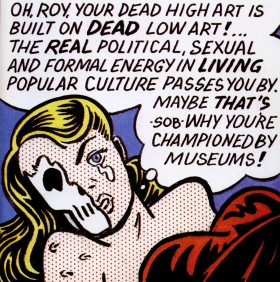
On Lichtenstein’s contribution to comic art…
My one-liner on this, because I’ve had to discuss it in the past is, “Lichtenstein did no more or less for comics than Warhol did for soup.”
On to what degree his “anti-PC” works are meant to shock…
Mad comics is what shaped me. And Mad was, by its very nature, transgressive. More so than anybody realized. I believe, seriously, that Mad comics is what allowed a generation to protest the Vietnam War. It’s linear. It’s not like, “Oh, that was ambient, and these other things were ambient.” It was there, and it made the difference. And so it shaped me. It really shaped me. And I always had a tendency to… I was kind of contrarian. But when you say “anti-PC”, I don’t want it to be mistaken for Libertarian. But it is this thing of feeling that it’s important to poke at stuff, and see what’s underneath it. The underground comics thing came along and helped me have a place to do that. But even before that, I was working for a magazine called The Realist, which was Paul 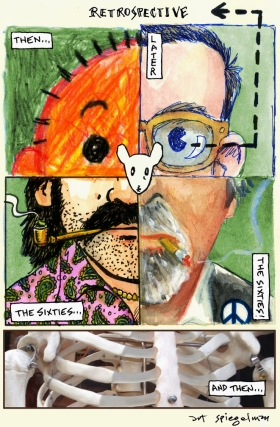 Krassner‘s really significant free-thinking magazine. But then I was also, when I was 14 years old, and didn’t know better, I worked for an anti-Castro magazine. Because I was 14 years old, and one of the key artists for Mad was [Antonio Prohías], who did Spy vs. Spy. And I figured any place where a Mad artist worked, I had to try to at least get something published, if they’d have me. So I had no politics at the age of 14 that were worth knowing. But there I was doing that. So, it was really just sort of looking around to see where I needed to go. During the Vietnam War, it was a no-brainer where I had to like land. There were things that I’ve gotten more knowledgeable about. Like the underground comics thing, I was just talking about this with somebody within the last 24 hours. There was a thing called the “Alternative Media Conference” in Vermont in, I think, ’67 or ’68. And actually, Paul Krassner just wrote about it in The Huffington Post. And during this media conference, I was there, and it was like all the underground press people were there. And it was invaded by feminists. And at that time, I wasn’t aware of feminists. It was just not in my radar. And they were such spoilsports. And I didn’t understand what their problem was, but they really busted up the underground comics conference something fierce. Meanwhile or right after, Harvey Kurtzman, my hero who created Mad, was having a conference elsewhere — where he had done all of this
Krassner‘s really significant free-thinking magazine. But then I was also, when I was 14 years old, and didn’t know better, I worked for an anti-Castro magazine. Because I was 14 years old, and one of the key artists for Mad was [Antonio Prohías], who did Spy vs. Spy. And I figured any place where a Mad artist worked, I had to try to at least get something published, if they’d have me. So I had no politics at the age of 14 that were worth knowing. But there I was doing that. So, it was really just sort of looking around to see where I needed to go. During the Vietnam War, it was a no-brainer where I had to like land. There were things that I’ve gotten more knowledgeable about. Like the underground comics thing, I was just talking about this with somebody within the last 24 hours. There was a thing called the “Alternative Media Conference” in Vermont in, I think, ’67 or ’68. And actually, Paul Krassner just wrote about it in The Huffington Post. And during this media conference, I was there, and it was like all the underground press people were there. And it was invaded by feminists. And at that time, I wasn’t aware of feminists. It was just not in my radar. And they were such spoilsports. And I didn’t understand what their problem was, but they really busted up the underground comics conference something fierce. Meanwhile or right after, Harvey Kurtzman, my hero who created Mad, was having a conference elsewhere — where he had done all of this 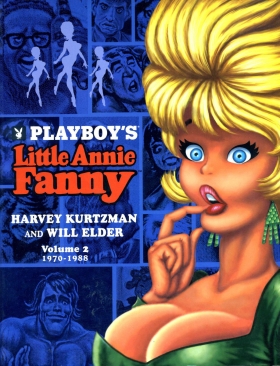 transgressive work, but at that point he was doing Little Annie Fanny for Playboy. So there were the feminists, but there were also the hippies. And two of the hippies started fucking in the middle of the conference, and busted up that conference. So, that was then. And I was existing somewhere between these two zones, trying to understand what had hit me. Why were these women so angry? And as I figured out after a while, it’s nothing like being socked in the face, and given 10 years to cogitate. Nothing like that for rewiring your brain. So, it took a long time for me to understand all this. But I was moving in the directions that I saw as against the grain, very often. And at one point, that consisted of doing stuff for a comic book called Sleazy Scandals of the Silver Screen, and for something called… which one was it? I don’t remember if it was Jiz or [Snatch] comics, but those were two of the underground comics titles that were coming out at the time. But things change. So like I said, the first underground comics stuff was very violent. But it didn’t have any solid content. And it’s what allowed the Maus work to grow out of those first eruptions.
transgressive work, but at that point he was doing Little Annie Fanny for Playboy. So there were the feminists, but there were also the hippies. And two of the hippies started fucking in the middle of the conference, and busted up that conference. So, that was then. And I was existing somewhere between these two zones, trying to understand what had hit me. Why were these women so angry? And as I figured out after a while, it’s nothing like being socked in the face, and given 10 years to cogitate. Nothing like that for rewiring your brain. So, it took a long time for me to understand all this. But I was moving in the directions that I saw as against the grain, very often. And at one point, that consisted of doing stuff for a comic book called Sleazy Scandals of the Silver Screen, and for something called… which one was it? I don’t remember if it was Jiz or [Snatch] comics, but those were two of the underground comics titles that were coming out at the time. But things change. So like I said, the first underground comics stuff was very violent. But it didn’t have any solid content. And it’s what allowed the Maus work to grow out of those first eruptions.
On his literary influences…
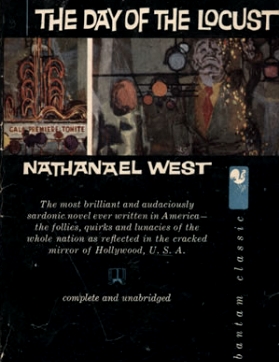 [Franz] Kafka really was an influence. Even though it seems like so pretentious to say so. But I really saw it as a late entry into The Twilight Zone series of television shows. And it hit a nerve, in terms of the anxiety, and the fact that they were funny, in their own way. And then, equally important was maybe somebody who’s also an inheritor of something from Kafka, who was Philip K. Dick, who I didn’t discover until first year of college — but at a time where he really was “Kilgore Trout.” Nobody knew what he was up to. And also, I would say Day of the Locust was a really important book for me. And I’ve read it many, many times since. And I suppose, the other one that was really important was Catch-22. When I was in high school, I just read it over and over again. Those are the ones that I know they’re important, because I’ve read them many times.
[Franz] Kafka really was an influence. Even though it seems like so pretentious to say so. But I really saw it as a late entry into The Twilight Zone series of television shows. And it hit a nerve, in terms of the anxiety, and the fact that they were funny, in their own way. And then, equally important was maybe somebody who’s also an inheritor of something from Kafka, who was Philip K. Dick, who I didn’t discover until first year of college — but at a time where he really was “Kilgore Trout.” Nobody knew what he was up to. And also, I would say Day of the Locust was a really important book for me. And I’ve read it many, many times since. And I suppose, the other one that was really important was Catch-22. When I was in high school, I just read it over and over again. Those are the ones that I know they’re important, because I’ve read them many times.
On his opinion of the term “graphic novel”…
Maus is called a graphic novel about the Holocaust. I have problems with both phrases. “Holocaust” means burnt offering. “Graphic novel” is god knows what, but it’s not usually non-fiction. A lot of what I’ll doing at BAM, that lecture is about how that phrase came into existence, and why, and what it made possible. The precursors of the graphic novel actually gave me permission to make the Prisoner on the Hell Planet strip, and other approaches to comics that didn’t come from the wiseguy transgressive side of the street, necessarily.
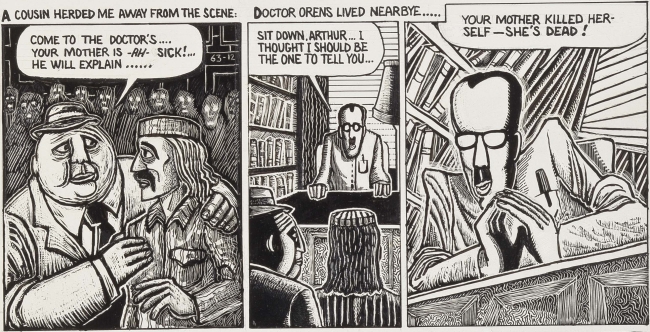
The woodcut novels of Lynd Ward and [Frans] Masereel, and a few others. I don’t love the phrase. I’m amazed at how well it worked. I mean, as marketing it’s fantastic. But as descriptive, I’m not sure there’s a problem with the word “comics” that’s equally a misnomer. But we already had a misnomer. We didn’t need a new one. But I can’t spend a lot of time worrying about it. It’s like when it’s useful — like, I’m sure for certain young artists, it’s very useful to be able to say that they’re graphic novelists. It’s much easier to get dates, than when I was a kid and said I did comics. So there’s that.
On what the future holds for comics in the art market…
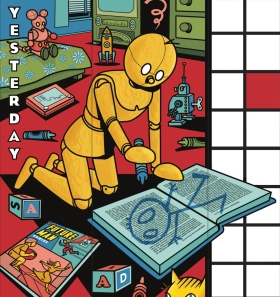 I don’t know. I mean, the art world is this thing now that… it was phrased very well by my friend Chris Ware, who said like when he was doing this stuff, he always thought that “art” was a historical term that referred to things done between a certain year and a certain other year. Which is basically — he didn’t say this — but it’s basically as if now we’re living in a world where it’s the Invasion of the Body Snatchers. There’s other things that came along and took over that thing called “art,” and made something that maybe I’ll feel differently if I get to live ’til 2060, and look back on this stuff. But for me, it’s very hard for me to focus on a lot of things that are called that. So yeah, it could include comics. I think comics, because they require a lot of craft, very often, will fall into a certain zone where if craft values are part of what comes to the fore in the universe called “the art world” right now — yeah, then maybe. Actually, you know, the real answer to this question is something that got garbled in that interview answer in The [New York] Times. Which is, when I made that Faustian deal, it worked like a charm for bookstores, libraries, universities, and comics, because it came through the storytelling end of it. And the book, as an object, has only become a stronger object in the world, as other books get kindled. So, there’s that. But I didn’t think it fully through with the life of comics in museums and galleries. Because it became clear to me, only when that
I don’t know. I mean, the art world is this thing now that… it was phrased very well by my friend Chris Ware, who said like when he was doing this stuff, he always thought that “art” was a historical term that referred to things done between a certain year and a certain other year. Which is basically — he didn’t say this — but it’s basically as if now we’re living in a world where it’s the Invasion of the Body Snatchers. There’s other things that came along and took over that thing called “art,” and made something that maybe I’ll feel differently if I get to live ’til 2060, and look back on this stuff. But for me, it’s very hard for me to focus on a lot of things that are called that. So yeah, it could include comics. I think comics, because they require a lot of craft, very often, will fall into a certain zone where if craft values are part of what comes to the fore in the universe called “the art world” right now — yeah, then maybe. Actually, you know, the real answer to this question is something that got garbled in that interview answer in The [New York] Times. Which is, when I made that Faustian deal, it worked like a charm for bookstores, libraries, universities, and comics, because it came through the storytelling end of it. And the book, as an object, has only become a stronger object in the world, as other books get kindled. So, there’s that. But I didn’t think it fully through with the life of comics in museums and galleries. Because it became clear to me, only when that 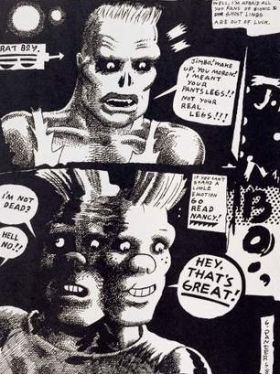 Masters of Comics show was in L.A., that certain things hang onto that wall a lot better than other things. So the only advantage I have when I’m there, is like my stuff looks like rejected Merzbau material, very often. It’s all like the rough sketches and the weird conglomerations that make something there, fits into some kind of inept craft tradition. But then, there’s other things where there are people who train to be painters, like Gary Panter, who came up in that Sunday Times thing that I assume many of you have seen. He’s really making marks. And he’s making marks that have a strong half-life. And in that exhibition in California, the Masters show, I saw that certain cartoons looked great on the wall, certain other ones less so. So, Peanuts is an amazing accomplishment. Charles Schulz‘s strip. But you look at it in that little room that was set up for it at the Hammer Museum, and it looks like children’s wallpaper after a while. It’s very neat. It’s very clean. It’s there. You see something by seeing one or two. Do you see a lot when you see more of it? Mmm, not so much. But for some reason, Chester Gould looks like better than Jim Nutt at his prime. It’s great on the wall. And so, each artist has a different relationship to it. And as a result, I now believe that there’s certain things that will look better as individual objects on a wall. And the book that will come out is basically a catalog that records what is, in its ultimate state, a unique drawing. Other things, equally valuable, may look better in a book, and may be of some anecdotal or other interest to see the originals. But it’s something else.
Masters of Comics show was in L.A., that certain things hang onto that wall a lot better than other things. So the only advantage I have when I’m there, is like my stuff looks like rejected Merzbau material, very often. It’s all like the rough sketches and the weird conglomerations that make something there, fits into some kind of inept craft tradition. But then, there’s other things where there are people who train to be painters, like Gary Panter, who came up in that Sunday Times thing that I assume many of you have seen. He’s really making marks. And he’s making marks that have a strong half-life. And in that exhibition in California, the Masters show, I saw that certain cartoons looked great on the wall, certain other ones less so. So, Peanuts is an amazing accomplishment. Charles Schulz‘s strip. But you look at it in that little room that was set up for it at the Hammer Museum, and it looks like children’s wallpaper after a while. It’s very neat. It’s very clean. It’s there. You see something by seeing one or two. Do you see a lot when you see more of it? Mmm, not so much. But for some reason, Chester Gould looks like better than Jim Nutt at his prime. It’s great on the wall. And so, each artist has a different relationship to it. And as a result, I now believe that there’s certain things that will look better as individual objects on a wall. And the book that will come out is basically a catalog that records what is, in its ultimate state, a unique drawing. Other things, equally valuable, may look better in a book, and may be of some anecdotal or other interest to see the originals. But it’s something else.